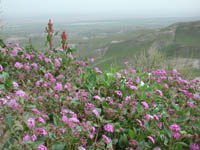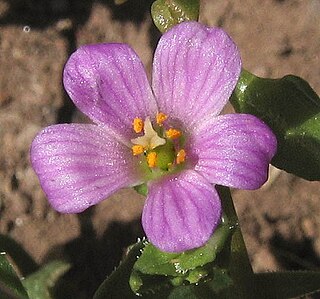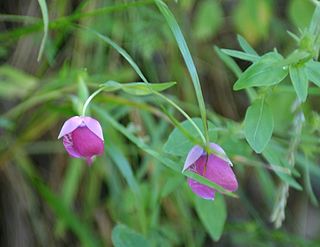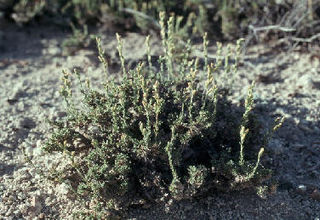
Androsace, commonly known as rock jasmine, is a genus of flowering plants in the family Primulaceae, second only to Primula in the number of species. It is predominantly Arctic–alpine, with many species in the Himalayas, the mountains of central Asia, the Caucasus, and the southern and central European mountain systems, particularly the Alps and the Pyrenees.

Alisma lanceolatum is a species of aquatic plant in the water plantain family known by the common names lanceleaf water plantain and narrow-leaved water plantain. It is widespread across Europe, North Africa and temperate Asia. It is naturalized in Australia, New Zealand, Oregon, California and British Columbia. It is considered a noxious weed in some places.

Abronia pogonantha is a species of flowering plant in the four o'clock family (Nyctaginaceae) known by the common name Mojave sand-verbena. It is native to California and Nevada, where it grows in the Mojave Desert, adjacent hills and mountains, and parts of the San Joaquin Valley in the Central Valley.

Arctostaphylos mewukka is a species of manzanita known by the common name Indian manzanita.

Artemisia nova is a North American species of sagebrush, known by the common name black sagebrush. It is "one of the most common shrubs in the western United States".

Atriplex lentiformis is a species of saltbush.

Calandrinia breweri is a species of flowering plant in the family Montiaceae known by the common name Brewer's redmaids.

Calochortus amoenus is a species of flowering plant in the lily family which is commonly known as purple fairy-lantern.

Lachnagrostis filiformis is a species of grass known by the common names Pacific bent grass, New Zealand wind grass, fairy grass, or blown-grass. It is native to Australia, New Zealand, and other Pacific Islands including New Guinea and Easter Island. While it is found in a wide variety of habitats, it seems particularly invasive in areas with damp soils, such as areas near bodies of water. It has been introduced to southern Africa, the United Kingdom, Taiwan, the southern United States and Mexico.

Carex raynoldsii is a species of sedge known by the common name Raynolds' sedge. It is native to western North America and grows in alpine to subalpine meadows.

Harrisia fragrans is a rare species of cactus known by the common name fragrant prickly apple. It is endemic to Florida, where it is known only from St. Lucie County. The plant's habitat has been almost completely consumed by development, leading to its rarity. It is a federally listed endangered species of the United States.

Anisocarpus madioides is a North American species of flowering plant in the family Asteraceae known by the common name woodland madia.
Psilocarphus oregonus is a species of flowering plant in the family Asteraceae known by the common names Oregon woollyheads and Oregon woolly marbles. It is native to western North America from Washington and Idaho to Baja California, where it grows in seasonally wet habitat, such as vernal pools.

Ribes montigenum is a species of currant known by the common names mountain gooseberry, alpine prickly currant, western prickly gooseberry, and gooseberry currant. It is native to western North America from Washington south to California and east as far as the Rocky Mountains, where it grows in high mountain habitat types in subalpine and alpine climates, such as forests and talus. It is a spreading shrub growing up to 1.5 meters tall, the branching stems covered in prickles and hairs and bearing 1 to 5 sharp spines at intervals.

Arnica dealbata is a species of Californian plants in the tarweed tribe within the aster family
Eriogonum evanidum is a rare species of wild buckwheat known by the common name vanishing wild buckwheat. It is native to southern California and Baja California, where it has been collected from widely scattered areas. Most historical occurrences are now extirpated. Some sources suggested that it was probably extinct, but living specimens were rediscovered in 2007.

Artemisia pygmaea is a North American species of sagebrush in the aster family known by the common name pygmy sagebrush.
Castilleja kerryana is a species of flowering plant in the family Orobanchaceae. It is commonly known as Kerry's Indian paintbrush or Kerry’spaintbrush. It was formally described in 2013 and so far it is known only from a small population in the state of Montana, in the Northwestern United States.

Androsace laevigata, synonym Douglasia laevigata, known as the cliff dwarf primrose, is a species of flowering plant in the primrose family, Primulaceae. It is native to the central Pacific coastal mountains of North America below 2,400 metres (8,000 ft) elevation. Its habitat includes cliffs, rocks, and alpine.
Androsace americana, synonym Douglasia arctica, known as the Mackenzie River dwarf primrose, is a species of flowering plant in the primrose family, Primulaceae. It is native to subarctic North America.
















